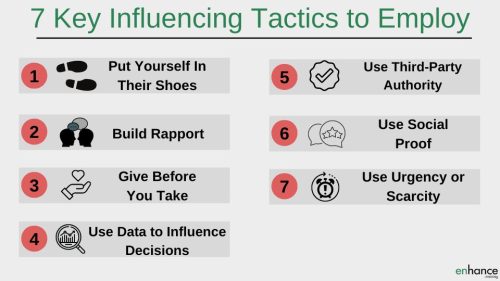How to influence your manager and the leadership team

When you enter the management ranks, a big part of your future success will depend on you learning how to influence others at work, how to influence your manager and potentially how to influence the leadership team. The closer you get to the leadership team, the more important it becomes to work out how to influence the leadership team, especially relating to those projects and activities that you are responsible for delivering.
At the end of the article I explain a practical approach to increasing your influence within groups such as the leadership team.
Being able to influence – is a set of skills anyone can learn, practice and get good at.
How to Influence Your Manager and the Leadership Team:
3 important factors when communicating with managers and leaders within your business
7 Key influencing tactics to employ
Increasing influence within the leadership team
Watch on YouTube
Listen on Podcast
3 important factors when communicating with managers and leaders within your business
Time is Precious – the first factor to consider for how to influence your manager or how to influence the leadership team
Managers are pulled in many directions and have many demands on their time. As those managers get more senior and progress into leadership roles, the competing demands on their time only increases.
Therefore, when communicating to managers and leaders, you must be concise. You need to get your message across quickly and clearly. Don’t go into lots of detail, send lengthy emails or give lengthy presentations. Put the key messages, insights or requirements at the beginning, and then justify or provide more detail after delivering the key messages. Managers want to know that you have gone into detail and know your stuff. They don’t often want to go into all the detail themselves. Therefore you must know the detail and be able to demonstrate you know it, without necessarily going through it. Less is often more in how you communicate with senior people.

Flexing Your Communication Style – the second factor to consider when thinking about how to influence leaders and managers
To choose the right style of communication, you need to get to know the person you are influencing. How do they like being communicated with?
Do they want you to get straight to the point, provide your analysis and await their decision? Or would they prefer to ask how your week has been, catchup on mutual interests and then talk business? Or do they want to know what actions you are recommending and why? We all respond to certain communication styles better than others. And the situation can change which style we prefer to receive.
Work out which communication style you are going use for which person in which situation.
Communication method to use – in person, phone or email. The third communication factor when thinking about how to influence your manager and others
Given a choice, I would always choose in person first, followed by the phone and lastly email or messaging. It is much easier to influence a person when you are face to face with them. You can pick up on all the non-verbal clues, see how your message lands and adjust it. With phone calls, you only have the tone and pace of the voice to get feedback. And with email you have next to no feedback.
Plus building relationships is much easier face to face, harder on the phone and very hard via email.
So try to influence others in person as much as you can – it is a lot easier.
7 key influencing tactics to employ
Now I am going to go through 7 key influencing tactics that marketeers, salespeople and business managers and leaders use day in day out because they work.
Put yourself in their shoes – the first tactic to use when thinking about how to influence your manager
What are their goals, ambitions, interests, and work objectives? What do they need to achieve to look good, get promoted and get their annual bonus?
Think about what you want to achieve and how you can position your project, activity or request with your manager or the leadership team so that you are helping them achieve their goals and objectives. Explaining how you are going to be helping them achieve their goals is going to make your proposal more interesting to them. Because you are highlighting the personal incentive they have – it is going to make getting their help or signoff that much easier as a result.
Put yourself in the other person’s shoes and work out what they want. How to influence others at work means talking in their terms not yours.
Build rapport – the second tactic to use when thinking about how to influence your manager
Building relationships is equally important when thinking about how to influence the leadership team.
We all like to help and support people we like on a personal level. It is hardwired into human social history and skills. So build personal connections. Find out what they like to do, what hobbies they have, what sports team or charity they support. Get the other person talking about themselves and listen.
You also need to deliver in your day job. Performing above average, being a contributor, a team player, a problem solver, etc. all help to establish your credibility and increase your influence of others.
Likability and professional competence go a long way to building trust in the workplace. When someone trusts you, you are able to significantly increase your influence with that person.

Give before you take – the third tactic to use when thinking about how to influence others
This is often referred to as reciprocity. Again, all cultures are predisposed to help those that have help us first. So look out for opportunities where you can help others. When other staff members, managers and leaders ask for help, go out of your way to ensure you deliver what they need quickly.
Do this consistently, you become a go to person, with a reputation for helping and delivering. When you need to influence, ask for favours or get support, you are a lot more likely to get what you want.
Use data to influence decisions, back up your argument or suggested course of action – the fourth tactic when thinking about how to influence your manager or and how to influence the leadership team
Everyone has an opinion. So unfortunately, opinions don’t count for a lot unless you have supporting evidence to back up why you have the opinion you do. This evidence can take several forms. A key one is data.
A simple example would be:
“I think that this advert A is a better than Advert B and the higher view rates, click through rates and conversion rates – all confirm this”.
This statement is so much more persuasive than “I know Advert A is better – trust me”.
So take the time to gather the data, analyse it, provide insights, and use the data to influence and persuade others to take a particular course of action aligned to what the data is showing.
Use third-party authority – the fifth tactic to use when thinking about how to influence your manager or how to influence others at work
Articles from well-know publications such as Forbes or Harvard Business Review or YouTube videos from well-known and respected public speakers are great ways to build greater influence for what you want to achieve.
Use the third-party information as the centre piece of, rather than an addition to, your argument. If an HBR article is explaining why moving away from owned warehouses to using Third Party Logistics is more cost effective and provides greater flexibility – then use, refer and show this article and explain why the benefits in the article are relevant to your business and then present your proposal. Respected third-party authorities are seen as experts, they carry weight and will increase your influence when used correctly. A great example of how to influence the leadership team.
Use Social Proof – the Sixth tactic
Using Social proof is effectively saying we should be following the crowd. It is a powerful influencer when used in the right way and in the right circumstances.
An example would be to find out what your competitors are doing and if say 50%+ have already made the change that you would like to get sign off for, documents your findings and evidence and use this to influence your manager and the leadership team. Your message might effectively be “We need to do this or we will be left behind by our competitors”
Use what others are doing to increase your influence.
Use Urgency or Scarcity – both tap into the fear of missing out. The seventh tactic for how to influence your manager or how to influence the leadership team
There are usually time constraints to take advantage of business opportunities or to avoid or reduce risks. Use these constraints to influence getting sign off and taking action soon rather than later.
Resource constraints are also another form of scarcity that every business has to deal with. Resources include people, skills, suppliers, capacity, raw material, cash, funding etc. How can you use these constraints to influence the course of action you are proposing?
So there you have seven key tactics to increase your influence with your manger, the leadership team and anyone else you work with. And like all skills, you get better at using all of these with practice.
Growing your influence within a business should make it easier for you to be more effective, deliver more and speed up your promotions. Influencing skills are vital for any management or leadership position.
Increasing Influence Within the Leadership Team
And finally as mentioned at the start, an effective tactic to influence groups is to speak to each person in the group individually first – before meeting with the combined group.
By meeting with each person first, you get to
- Influence their thinking,
- Answer the questions they have in private,
- Incorporate any feedback or suggestions they have into your proposals
- Give them the level of data and information they need to fully understand the benefits of your proposal
- Understand and counter any objections they have
- Win supporters for your proposal
When you the go into the meeting to get a decision, signoff, resource allocation or whatever you need, you have gone through a dry run with each attendee and hopefully you have already won them over before the meeting starts.
This approach takes more time up front, but I promise you that you will save that investment many times over by avoiding group arguments, decision delays, refusals, requests for more information (another delay tactic) and similar.
For those important decisions and proposals, approach each individual before approaching the group as a whole.
In summary
So in summary – there you have three key communication factors, seven influencing tactics and a way to influence and build support with groups.
Developing influencing skills are a key skill group for leadership positions and very useful for management positions. Keep trying to improve your influencing skills – your career will thank you for it.

Knowing how to influence others at work is becoming a crucial part of some many jobs . Influencing influencing team members, peers, managers, and leaders all the way through to the leadership team itself – can make the difference between being seen to be doing okay at your job compared to doing an amazing job.
Build relationships and be more influencial!





